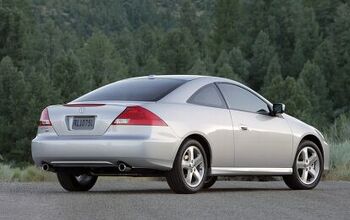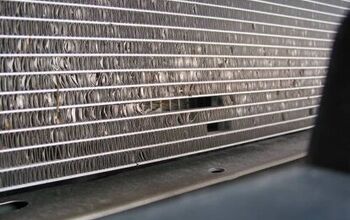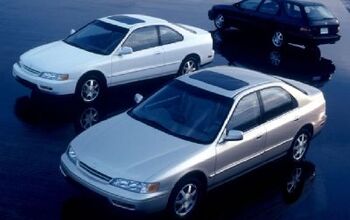Piston Slap: An Accord Awakening?

Sajeev,
I’ve been lurking TTAC for a few years now and I really enjoy visiting the site every day. I think I’ve learned quite a bit about how to get the most out of my cars. Here’s my most recent car issue: I recently inherited a 2004 Honda Accord EX-V6 with an automatic transmission. It was purchased new and only has about 44K miles on it.
The problem is this – it hasn’t moved in 4 years. It was in good condition before and was being driven daily. However, when the owner passed away, it was transferred to someone who doesn’t drive and that person left it sitting in a garage for 4 years until I got it.
Traditionally, I have not been very hands-on in my car care, but am starting to take baby steps into fixing things myself. My current ride is a 2004 Acura TSX 6-speed manual that I bought new and currently has about 150K miles on it. Aside from a few cosmetic issues, the car runs perfectly and has been reliable so far. I also love driving the TSX (especially due to the 6-speed), so until recently, I didn’t have any plans on replacing it.
So my question to you is this:
Should I –
(1) Sell the Accord as-is?
Thanks in advance for your help!
Sajeev answers:
Option #1 is a non-starter…literally! Get it? (snort)
Since you like the TSX, maybe cash from the Accord’s sale is better for you. It’s probably worth more to someone else! Invest the proceeds, save it for a rainy day, give it to charity, or burn it away in a Hunter S. Thompson-esque bender in Vegas…whatever man, it’s all good.
So I recommend option as it probably needs very little work to be a clean and awesome ride for craigslist, AutoTrader, Edmunds, local classifieds, etc. Here’s the stuff I recommend to recondition a car like this to ensure buyer confidence and a fat profit for yourself. In no particular order:
- Thoroughly detail inside and out, it might take a full day for a car sitting that long. Anyone can do this, and it’s very rewarding if you like to get your hands dirty.
- New tires: they might be flat spotted and are definitely not inspiring buyer confidence if they are original with that much age/mileage.
- New Battery: don’t forget to save the receipts!
- New fuel filter, after you run the old gas thru the system. Or dump the old gas out, if it won’t run on what’s in the tank. You might need a mechanic for this, if you don’t trust your skills.
- Oil Change, coolant change too.
- If it’s an EX with leather (aren’t they all?), marinate the hides in leather conditioner. Baby oil works in a pinch.
- Drive for a week or so, see if anything else goes wrong. Definitely run the HVAC system and deodorize if needed.
Honestly, given the low mileage and late-model status of this Honda, I don’t think it’ll need anything else! If outdoor storage, rat infestation, etc are mitigating circumstances we aren’t aware of, perhaps option #1 isn’t a bad idea.
Send your queries to sajeev@thetruthaboutcars.com. Spare no details and ask for a speedy resolution if you’re in a hurry.

More by Sajeev Mehta
Latest Car Reviews
Read moreLatest Product Reviews
Read moreRecent Comments
- W Conrad I'm not afraid of them, but they aren't needed for everyone or everywhere. Long haul and highway driving sure, but in the city, nope.
- Jalop1991 In a manner similar to PHEV being the correct answer, I declare RPVs to be the correct answer here.We're doing it with certain aircraft; why not with cars on the ground, using hardware and tools like Telsa's "FSD" or GM's "SuperCruise" as the base?Take the local Uber driver out of the car, and put him in a professional centralized environment from where he drives me around. The system and the individual car can have awareness as well as gates, but he's responsible for the driving.Put the tech into my car, and let me buy it as needed. I need someone else to drive me home; hit the button and voila, I've hired a driver for the moment. I don't want to drive 11 hours to my vacation spot; hire the remote pilot for that. When I get there, I have my car and he's still at his normal location, piloting cars for other people.The system would allow for driver rest period, like what's required for truckers, so I might end up with multiple people driving me to the coast. I don't care. And they don't have to be physically with me, therefore they can be way cheaper.Charge taxi-type per-mile rates. For long drives, offer per-trip rates. Offer subscriptions, including miles/hours. Whatever.(And for grins, dress the remote pilots all as Johnnie.)Start this out with big rigs. Take the trucker away from the long haul driving, and let him be there for emergencies and the short haul parts of the trip.And in a manner similar to PHEVs being discredited, I fully expect to be razzed for this brilliant idea (not unlike how Alan Kay wasn't recognized until many many years later for his Dynabook vision).
- B-BodyBuick84 Not afraid of AV's as I highly doubt they will ever be %100 viable for our roads. Stop-and-go downtown city or rush hour highway traffic? I can see that, but otherwise there's simply too many variables. Bad weather conditions, faded road lines or markings, reflective surfaces with glare, etc. There's also the issue of cultural norms. About a decade ago there was actually an online test called 'The Morality Machine' one could do online where you were in control of an AV and choose what action to take when a crash was inevitable. I think something like 2.5 million people across the world participated? For example, do you hit and most likely kill the elderly couple strolling across the crosswalk or crash the vehicle into a cement barrier and almost certainly cause the death of the vehicle occupants? What if it's a parent and child? In N. America 98% of people choose to hit the elderly couple and save themselves while in Asia, the exact opposite happened where 98% choose to hit the parent and child. Why? Cultural differences. Asia puts a lot of emphasis on respecting their elderly while N. America has a culture of 'save/ protect the children'. Are these AV's going to respect that culture? Is a VW Jetta or Buick Envision AV going to have different programming depending on whether it's sold in Canada or Taiwan? how's that going to effect legislation and legal battles when a crash inevitibly does happen? These are the true barriers to mass AV adoption, and in the 10 years since that test came out, there has been zero answers or progress on this matter. So no, I'm not afraid of AV's simply because with the exception of a few specific situations, most avenues are going to prove to be a dead-end for automakers.
- Mike Bradley Autonomous cars were developed in Silicon Valley. For new products there, the standard business plan is to put a barely-functioning product on the market right away and wait for the early-adopter customers to find the flaws. That's exactly what's happened. Detroit's plan is pretty much the opposite, but Detroit isn't developing this product. That's why dealers, for instance, haven't been trained in the cars.
- Dartman https://apnews.com/article/artificial-intelligence-fighter-jets-air-force-6a1100c96a73ca9b7f41cbd6a2753fdaAutonomous/Ai is here now. The question is implementation and acceptance.


































Comments
Join the conversation
Honda V6 automatic transmissions are not known for their longevity - get it serviced as part of its return to the road.
The struts are probably fine. I had a set of shocks that sat in my barn since 1991, couldn't even remember what I bought them for, but I remember when & where I got them. A buddy of mine bought an Econoline that had bad shocks, we looked at it and saw that the shocks I had would fit like a glove, so I gave them to him. He installed them and they work just fine. I've had many parts sit in my barn for 10-20, and probably close to 30 years. Sometimes when I eventually end up using them or giving them to someone they are normally fine. Parts often sit on shelves in auto parts stores for years before being sold if it's not a part that people commonly buy. Parts are also known to sit at salvage yards for years before being sold. The belt & hoses are probably fine. There are muscle cars at shows that still have the original belts & hoses. The climate to which they are exposed is the major factor that determines how long they last. The tires could or could not be flat spotted. I've seen some develop flat spots after sitting a short time, but I've also seen cars that have sat much longer than 4 years and the tires were fine. It probably depends on the quality of the tire, how much air they had, whether or not they were exposed to SUV rays, etc.